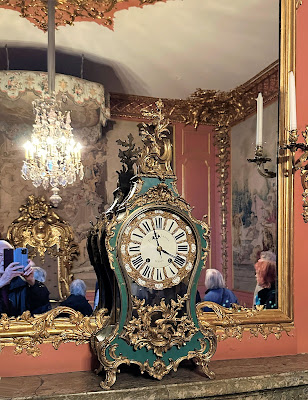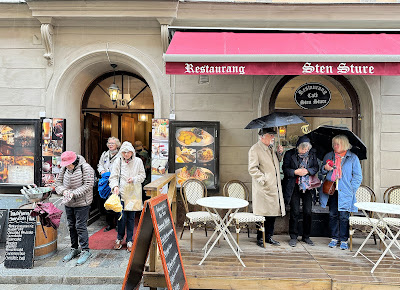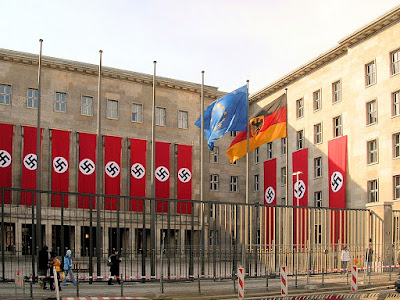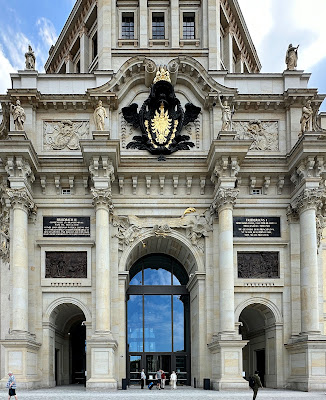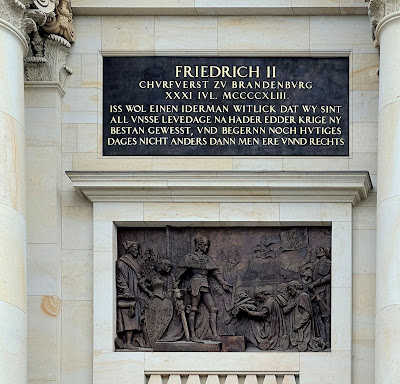Wikipedia knows:
The Humboldt Forum is a museum dedicated to human history, art, and culture,
located in the Berlin Palace on the
Museum Island
in the historic center of Berlin. It is in honor of the Prussian scholars
Wilhelm and
Alexander von Humboldt.

|
|
Berlin Castle and the Monument of the Great Elector around 1900
|
The Berlin City Palace (Berliner Stadtschloss), formally the Royal Palace,
was the principal residence of the House of Hohenzollern from 1443 to 1918.
Expanded by order of
King Frederick I of Prussia
according to plans by
Andreas Schlüter
from 1689 to 1713, it was thereafter considered a major work of Prussian
Baroque architecture.

|
Palace of the Republic, popularly derisively called
Erichs Lampenladen
(Erich's Lamp Shop).
Erich Honecker
was an East German leader.
|
The Stadtschloss was damaged during Allied bombings and the Battle of Berlin
in World War II and was demolished by the East German authorities in 1950.
In the 1970s, it became the location of the modernist East German Palace of
the Republic (the parliament building of East Germany).
After German reunification and several years of debate, particularly over the fraught historical legacy of both
buildings, the Palace of the Republic was demolished in 2009. The
reconstruction of the Berlin Palace started in 2013 and lasted until
2020.Whenever Red Baron was in Berlin, he observed
the building progress at the Humboldt Forum. The "museum" is now finished, and nearly all, mostly ethnological,
exhibitions have moved in. So I decided
to spend my birthday
at the Forum.
From my hotel near the
Hauptbahnhof, I took
the new subway line 5, which runs below
Unter den Linden to
Alexanderplatz. Stepping off the train at
Museumsinsel,
you have a surprise.
The barrel vault of the station presents a starry sky, a homage to
Schinkel's stage design for the opera The Magic Flute in 1816.

|
|
View of the Altes Museum and the Berliner Dom
|
The Humboldt Forum is the natural extension of a chain of museums flanked by
the Berlin Cathedral on the right.
A bronze model of the Humboldt Forum clearly shows how the
Stadtschloss rose again from scratch.
The entrance to the Forum, the side portal 3, faces the left arm of the Spree
River. The original facade was meticulously reconstructed.
On the left side of the portal, a plaque and a relief commemorate the first
king in (!) Prussia, Frederick I. Architect Andreas Schlüter presents the
model of the new palace to the king. In the background, master builder
Johann Friedrich Eosander
explains the palace extension plan to
Queen Sophie Charlotte. The Latin inscription reads, "
Frederick I King of Prussia, Elector of Brandenburg 1688-1713. I will
conduct my royal office in such a way that I know it is a public matter and
not my private affair."
On the right side, it is not Frederick the Great who is commemorated, but
Elector Frederick II of Brandenburg, who laid the foundation stone for the first Berlin castle in 1443. The accompanying
inscription in Low German reads, "
It is well known to everyone that we have never insisted on strife or war
throughout our lives and still today desire nothing but my honor and
right."
In the morning, I booked an English-language architectural tour, "All a facade?", because all German-language tours were overbooked. So we were only
nine people, and our guide took it friendly and easy.
Above is the original facade of the
Stadtschloss, and, yes, the replica,
built from scratch according to old photographs, is a concrete construction with
a "new" but familiar face. The front of the building is so long that the
wide-angle lens on my iPhone captured only half of it.

|
| LHS |

|
| RHS |
The courtyard (
Schlüterhof) has been faithfully rebuilt, including all its statues
and decorations.

|
|
Mercury is looking at Hercules.
|
Some salvaged originals are on display at the Sculpture Hall.
We were on historical grounds. At the Hohenzollern
Stadtschloss:

|
| HMS Victory |
The legend reads:
Kaiser Wilhelm II and his wife, Auguste Viktoria, received twelve silver ship models for their silver wedding anniversary in 1906. Among them
was the Victory, Nelson's flagship in the 1805 Battle of Trafalgar. In
leading the British to victory, the admiral was also establishing Great Britain's preeminence at sea.
Wilhelm II had the ships exhibited in his apartment at the palace. His
enthusiasm for all things maritime was closely linked to German imperial
politics. The empire was on a quest for global influence and expanded its
fleet considerably. This posed a particular challenge for Great Britain.
And the East German Palace of the Republic once stood here:

|
The Volkskammer (East German parliament) votes on German
unification.
Martin Kirchner, CDU deputy, at the ballot box.
(©ullstein bild)
|
The legend:
This is the place where the Volkskammer, nominally the country's highest
constitutional organ, met from 1976 onwards. Until the peaceful revolution
in the autumn of 1989, however, the Volkskammer was a rubber-stamp
parliament that simply ratified documents presented to it by the East
German party leadership.
The deputies used the above glass ballot box to vote in the first freely
elected Volkskammer in March 1990. It symbolized the new transparency of
parliamentary decision-making in a democracy. On 23 August 1990, it was
used to vote on East Germany's accession to the territory governed by the
Basic Law of the Federal Republic of Germany.
The eastern concrete facade of the Humboldt Forum, opening on a vast
terrace, remained undecorated.

|
The Western sun is reflected in the sphere of the TV tower, forming
the shape of a cross. This optical phenomenon was
a
stake in the flesh of the communist rulers in East Berlin.
|
From the terrace facing the right arm of the Spree, you may admire the
excursion boats and the Berlin TV tower.
At the end of the guided tour, and it being my birthday, I invited the
participants to an aperitif at the Schlüterhof.
In the afternoon, I started with the following:
This is an exhibition on the historically and currently globally networked city
of Berlin. Various "information islands" named Revolution, Boundaries, Fashion,
Dictatorship, Emigration, etc., are each accessible through two gates asking the
visitor to decide: conservative, liberal, left-leaning, progressive, religious,
nationalist, cosmopolitical, you name it. Red Baron was equipped with a sensor
and went through the exhibition. The decisions he took at the gates were
recorded.
You can spend hours in "Berlin Global." Here are some objects that caught my
attention:

|
|
And when the wall came tumbling down ...
|

|
|
... behind the Potsdamer Platz was barren and empty.
|
Emigration. The legend tells us:
When the Nazis established their dictatorship, many artists - Jews,
communists, liberals, and others - were sacked as "undesirable elements." They
were banned from working and persecuted. Thousands of artists were forced into
exile. This is vividly illustrated here by the signatures of 43 theatre and
film workers from Berlin. They all had links to Max Reinhardt.
Most of them had to face immigration rules and restrictive labor laws that
made it difficult to get settled in their new countries. Actors were affected explicitly by language problems. Many of them had to find
alternative work.
Other exiles were able to leverage their professional experience to gain influence
in Hollywood film production.
Here is the result of my evaluation based on my choice of gates: Equality is not
too bad, but I had hoped for more Freedom.
I needed a coffee break, and for a moderate fee of 3 euros, I found my way to
the Dachterassencafé (rooftop café) Baret. As a bonus, I enjoyed
a fantastic view.

|
View of the Museum Island. On the left side is the German Historical
Museum,
and on the right is the Berlin Cathedral.
The high
building in the back, on the left, is the Charité hospital.
|

|
| The castle cupola |
The Prussian King Frederick William IV chose the script surrounding the dome in
1844. He took these words from the Bible: "Salvation is not found in no one
else, (...) but in the name of Jesus. That at the name of Jesus, all the knees
of those in heaven and on earth and under the earth should bow." (Acts IV, 12
and Philippians II, 10).
The inscription, characterized by the rule of divine
grace and therefore highly controversial, was re-engraved true to the original.

|
View toward the east. From the left: St. Mary Church, Berlin's TV
tower,
the steeple of the Red Town Hall, Nikolei Church, and I don't know. |
After the break, I visited
Nach der Natur im Humboldt Labor (After
Nature at the Humboldt Laboratory.

|
|
Here I learned about "interaction."
|
What a deception. The exposed items were poorly illuminated, the inscriptions
were hard to read, and the experiments didn't work. An exhibition conceived by
physicists of the Humboldt University without professional help?
I was tired and had dinner with a family member at an outdoor restaurant.
**





















